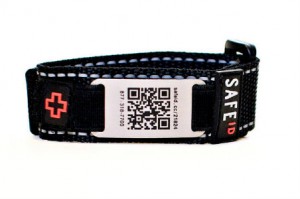Some years ago, before QR codes and smart phones could conjure reams of information with a point and a click, I went to the mall with a friend and our toddler children. We had settled into a table at the food court for lunch, and my friend had gone off to get some food, loosening the straps on her son’s stroller first to make him comfortable.
The three of us — my daughter, her son and I — chatted companionably for a while, and then, in an instant, he was up and bolting halfway across the mall. I will never forget my terror as I ordered my bewildered child not to move a muscle and to scream if anyone bothered her before I took off after him. After a chase, I found him in a sporting goods store, giggling innocently behind a rack of track suits. I snatched him up and carried him to his terrified mother who was, by then, sitting with my child. And I said a silent thank-you that a wandering child was not part of my daily life.
For many parents of children with autism, runaway kids are a constant danger
For too many parents, though, having a child who wanders—or bolts—is a nightmarish fact of life. It has long been known that children with autism spectrum disorder (ASD) have a tendency to take off on their own, but in 2012, the journal Pediatrics published a study confirming the alarmingly high incidence of kids with ASD who, in clinical terms, “elope.”
The study, conducted by a team of researchers in Baltimore, New York, Philadelphia and the Centers for Disease Control via the Interactive Autism Network, queried parents of 1,218 children with ASD. It found that 49 percent had wandered off at least once after the age of four. Of these, 24% were in places where they were at risk of drowning and 65% were in danger of injuries in traffic. Some 56 percent of the parents queried said that their children’s wandering was the most stressful behavior of the ASD diagnosis, while 50 percent said that they had received little no guidance in how to deal with it. The study pointed to “the urgent need to develop interventions to reduce the risk of elopement [and] to support families dealing with this issue….”
Around the same time that the study was under way, in the small town of Fergus Falls, Minnesota, the Holmquist family was dealing with the same issue. Their son had been diagnosed as autistic at the age of two-and-a-half and he had wandered away a few times. It was always scary, says Matt Holmquist, a controller for a window company. The first time he wandered away, they found him at the home of a neighbor whose property is on a lake. They worried that if he wandered away in a crowd, even if someone found him, they wouldn’t learn his name, as his autism limited his ability to speak.
Matt and his wife Laura considered a traditional medical-alert bracelet, but quickly concluded that it might pose more of a risk, revealing the child’s personal diagnosis to everyone he encountered. Nor did the small tags on most medic-alert bracelets have enough space to give all the necessary information. Then they hit on the idea of a bracelet imprinted with a QR code. When scanned, it would link to a website explaining his condition and giving their contact information and other important details. They realized that other families could use a bracelet like this, and decided to go into business.
Kids’ diagnoses concealed with QR codes
Their KeepMeSafeID debuted in December 2012. It costs $30 for a bracelet with unique QR code and access to a personal password-protected web profile page that they can customize and update indefinitely at no extra cost. Additional medical conditions, medications, alternate emergency contacts, insurance information and any other data can likewise be posted on the individual profile page. (Holmquist’s son finds the alphabet song calming, so that detail is included on his page. The bracelets are made of nylon hook-and-loop material and elastic, and the QR codes are engraved on stainless steel tags. The Holmquists initially made them by hand, but have since partnered with a factory in China.
Knowing that their son and others with ASD are hypersensitive to uncomfortable clothing and jewelry, the Holmquists also designed a soft, fuzzy sleeve that covers the bracelet and holds it on. Their son loves the feel of his “minky” sleeve. The bracelets come in a variety of attractive designs. Besides providing information to the person who finds the wandering child, the bracelet, once scanned, sends a message alert via text or email to the wearer’s emergency contact and activates a GPS locator.
If the person who finds the wanderer does not have a smart phone handy, the bracelet is also imprinted with the URL of the profile page, and a toll-free number for KeepMeSafeID. Nor is the product just for families dealing with ASD. IT can be used by caregivers of people with Alzheimer’s, dementia, Down syndrome, epilepsy and other conditions; emergency service personnel whose work puts them in harm’s way; and even joggers and bicyclists and business travelers who venture out on their own. The bracelet is available via the KeepMeSafeID website, and in selected running stores. “We also have some other ideas up our sleeve, but we have to take one step at a time,” says Holmquist. “Our primary goal is to get our IDs in the hands of as many people as possible to provide them peace of mind.”
